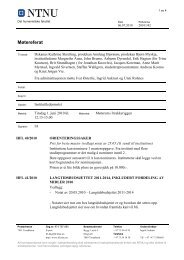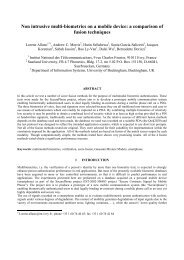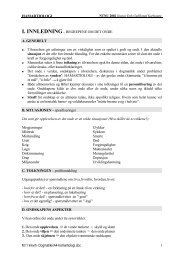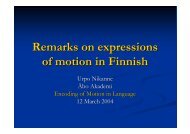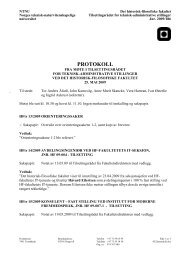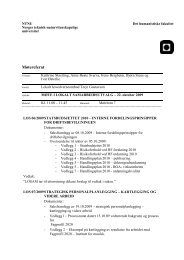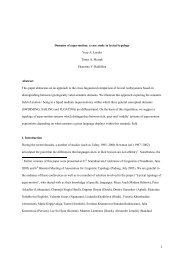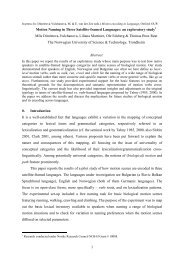The perception of articulation rate
The perception of articulation rate
The perception of articulation rate
You also want an ePaper? Increase the reach of your titles
YUMPU automatically turns print PDFs into web optimized ePapers that Google loves.
<strong>The</strong> Perception <strong>of</strong> Articulation Rate<br />
Jacques Koreman<br />
Institute <strong>of</strong> Phonetics, Saarland University, Germany<br />
jkoreman@coli.uni-sb.de<br />
ABSTRACT<br />
Segmental as well as prosodic utterance characteristics<br />
determine listeners' <strong>perception</strong> <strong>of</strong> speaking <strong>rate</strong>. <strong>The</strong><br />
segmental characteristics are usually captured by the<br />
<strong>articulation</strong> <strong>rate</strong>, which is sometimes based on the<br />
canonical, underlying representation and at other times<br />
on the actual, surface realisation <strong>of</strong> phones in an<br />
utterance. <strong>The</strong> relation between the two is defined by the<br />
phone deletion <strong>rate</strong>. Both the underlying and the surface<br />
structure are shown to play a role in the <strong>perception</strong> <strong>of</strong><br />
speaking <strong>rate</strong> and must (in addition to other related <strong>rate</strong><br />
phenomena) be taken into account when modelling<br />
speaking <strong>rate</strong>.<br />
1. INTRODUCTION<br />
Differences in speaking <strong>rate</strong> can be reflected by a variety<br />
<strong>of</strong> phonetic and phonological properties. <strong>The</strong> number<br />
and duration <strong>of</strong> pauses [1] as well as the number and<br />
strength <strong>of</strong> prosodic phrase boundaries, the use <strong>of</strong> F0<br />
resets to signal them, the complexity <strong>of</strong> pitch accents<br />
(bitonal versus monotonal) as well as F0 range can vary<br />
with speaking <strong>rate</strong> [2-4]. Some <strong>of</strong> these characteristics<br />
have been shown to play a role in the <strong>perception</strong> <strong>of</strong><br />
speaking <strong>rate</strong> [5]. Between pauses, <strong>articulation</strong> <strong>rate</strong> also<br />
varies, though to a lesser extent than overall speaking<br />
<strong>rate</strong> – and presumably contributes to the general<br />
impression <strong>of</strong> speaking <strong>rate</strong>. Intonation phrases (IP's)<br />
have been identified as the domain <strong>of</strong> speaking <strong>rate</strong><br />
variation [6] and were selected to evaluate speaking <strong>rate</strong><br />
in the study reported here.<br />
Lindblom [7] describes speaking <strong>rate</strong> as a result <strong>of</strong> the<br />
interplay between output-oriented control, i.e. the need<br />
for a speaker to (be able to assume he will) reach his<br />
communicative goal, and system-oriented control, i.e. his<br />
tendency to "default to some low-cost form <strong>of</strong> behavior".<br />
If output-oriented constraints are strong, the speaker can<br />
either speak slowly or move his articulators from one<br />
target position to the next at greater than normal speed,<br />
resulting in a clear speaking style (hyperspeech), even at<br />
high speaking <strong>rate</strong>s. Otherwise, system-constraints, e.g.<br />
due to inertia <strong>of</strong> the articulators, will lead him to<br />
economise on his articulatory effort and adopt a relaxed,<br />
conversational speaking style (hypospeech).<br />
<strong>The</strong> difference between the two articulatory st<strong>rate</strong>gies<br />
implies that the <strong>perception</strong> <strong>of</strong> speaking <strong>rate</strong> may be a<br />
product <strong>of</strong> actual articulatory events and knowledge <strong>of</strong><br />
what <strong>articulation</strong>s are implied by a particular utterance.<br />
This is not Motor <strong>The</strong>ory in the strict sense [8], but does<br />
appeal to the listener's knowledge <strong>of</strong> the required motor<br />
patterns. <strong>The</strong> two articulatory st<strong>rate</strong>gies are indirectly<br />
reflected in the realised phone <strong>rate</strong>s and in the<br />
corresponding <strong>rate</strong>s for the intended or canonical phones<br />
(which we shall call intended <strong>rate</strong>s). In the German Kiel<br />
Corpus <strong>of</strong> Spontaneous Speech [9] the intended and<br />
realised <strong>articulation</strong> <strong>rate</strong>s <strong>of</strong> IP's show a strong overall<br />
correlation (r = 0.928, p < 0.001), cf. [10]. With<br />
increasing intended phone <strong>rate</strong>s, more phones are deleted<br />
from the canonical pronunciation (Pearson's correlation<br />
between intended phone <strong>rate</strong> and the ratio <strong>of</strong><br />
realised/intended phone <strong>rate</strong>: r = –0.515, p < 0.001), so<br />
that both the measured phone <strong>rate</strong> and the phone deletion<br />
<strong>rate</strong> are possible cues for perceived speaking <strong>rate</strong>. To test<br />
this, we used stimuli with carefully selected intended and<br />
realised phone <strong>rate</strong>s.<br />
2. METHOD<br />
Stimuli were selected from the segmentally and<br />
prosodically manually labelled German Kiel Corpus <strong>of</strong><br />
spontaneous speech. <strong>The</strong> corpus consists <strong>of</strong> high-quality<br />
recordings <strong>of</strong> conversations in which two speakers<br />
schedule one or more appointments. Despite the<br />
recording set-up, in which the speakers had to press a<br />
button to obtain the floor, the speech is very natural.<br />
Intonation phrases (IP's) were selected on the basis <strong>of</strong><br />
their intended and realised <strong>articulation</strong> <strong>rate</strong>s computed<br />
from the canonical phone representation <strong>of</strong> each phrase<br />
and the actually realised phones, respectively.<br />
Incomplete reductions (i.e. quantitative and qualitative<br />
reductions which do not entail the deletion <strong>of</strong> a complete<br />
phone segment) do not affect the realised phone <strong>rate</strong> and<br />
were therefore not taken into consideration. It is<br />
expected that phrases with more numerous deletions also<br />
show a greater number <strong>of</strong> incomplete reductions (and<br />
vice versa), since these can be considered as a less<br />
extreme but otherwise similar effect <strong>of</strong> a sloppy<br />
<strong>articulation</strong>, but their effect on <strong>perception</strong> is not<br />
investigated here. Since the phrases were to be judged in<br />
pairs, we only selected phrases <strong>of</strong> similar duration (1–1.5<br />
seconds) in order to control for a possible effects <strong>of</strong><br />
phrase duration [11]. <strong>The</strong> selected phrases varied<br />
systematically in their intended and realised <strong>articulation</strong><br />
<strong>rate</strong>s, allowing us to evaluate the effect <strong>of</strong> <strong>articulation</strong><br />
<strong>rate</strong> per se and differentiate it from that <strong>of</strong> speaking style<br />
(clear versus sloppy) on listeners' <strong>perception</strong>. Six <strong>rate</strong><br />
categories were selected (cf. Fig. 1):<br />
FC<br />
Fast, clear IP's had high intended and realised<br />
phone <strong>rate</strong>s. Intended phone <strong>rate</strong>s were between 1<br />
and 2 standard deviations above the mean. <strong>The</strong><br />
realised phone <strong>rate</strong>s were close to the intended
FS<br />
NCf<br />
phone <strong>rate</strong>s, with a low phone deletion <strong>rate</strong><br />
(maximally 8%). <strong>The</strong> realised phone <strong>rate</strong>s <strong>of</strong><br />
these phrases were about 2-3 standard deviations<br />
above the mean.<br />
<strong>The</strong> intended phone <strong>rate</strong>s for the fast but sloppy<br />
phrases were similar to those <strong>of</strong> the clear phrases,<br />
but 35–40% <strong>of</strong> the intended phones were not<br />
realised. <strong>The</strong> realised phone <strong>rate</strong> was therefore<br />
much lower than in the fast, clear category,<br />
namely within one standard deviation <strong>of</strong> the mean<br />
(all above the mean, except for two phrases).<br />
A third category <strong>of</strong> clearly spoken phrases was<br />
selected, with intended and realised phone <strong>rate</strong>s<br />
similar to the realised phone <strong>rate</strong>s <strong>of</strong> the fast,<br />
sloppy speech. <strong>The</strong> percentage <strong>of</strong> phone deletions<br />
was comparable to that in the FC category. <strong>The</strong><br />
intended phone <strong>rate</strong>s were within about 0.5<br />
standard deviation from the mean. This category<br />
is named normal, clear phrases for comparison<br />
with fast intended phrases (NCf).<br />
As we noted above, output-oriented constraints can lead<br />
a speaker to slow his speech down or increase articulator<br />
speed in order to prevent undershoot [12]. Since at fast<br />
intended <strong>articulation</strong> <strong>rate</strong>s the inertia <strong>of</strong> the articulators<br />
(which itself is constant) creates a strong force to slow<br />
down or reduce phones, the lack <strong>of</strong> phone deletions in<br />
category FC is taken as a sign <strong>of</strong> strong output-oriented<br />
constraints and therefore a clear case <strong>of</strong> hyperspeech.<br />
Conversely, the deletion <strong>of</strong> phones at slower speaking<br />
<strong>rate</strong>s is a sign <strong>of</strong> extremely lax output constraints,<br />
allowing system-oriented constraints to induce<br />
hypospeech (category NS below). In order to evaluate<br />
whether the different relative weight <strong>of</strong> output and<br />
system constraints is taken into account by the listener in<br />
his judgment <strong>of</strong> speaking <strong>rate</strong>, another set <strong>of</strong> stimuli was<br />
selected from the slower half <strong>of</strong> the intended <strong>articulation</strong><br />
<strong>rate</strong> range (normal to slow):<br />
NCs Normal, clearly spoken phrases were selected<br />
with similar intended and realised phone <strong>rate</strong>s to<br />
those <strong>of</strong> the NCf category (but with all intended<br />
phones being realised), but the phrases were<br />
different ones. This was done in order to provide<br />
an optimal match with the phrases in the two<br />
categories below.<br />
NS<br />
SC<br />
Normal but sloppy intonation phrases showed<br />
phone deletion <strong>rate</strong>s between 35–40% (as in the<br />
FS category). This resulted in fairly slow realised<br />
phone <strong>rate</strong>s between –0.5 and –1.5 standard<br />
deviations from the mean.<br />
Finally, slow, but clear phrases were selected. <strong>The</strong><br />
phrases were matched to the NS phrases in their<br />
realised <strong>articulation</strong> <strong>rate</strong>s. <strong>The</strong> intended phone<br />
<strong>rate</strong>s are between –1 and –2 standard deviations<br />
from the mean.<br />
All possible combinations <strong>of</strong> the 6 categories were<br />
compared, giving 15 comparisons. Five sets <strong>of</strong> 6 phrases<br />
mean intended <strong>rate</strong> (phones/sec)<br />
24<br />
22<br />
20<br />
18<br />
16<br />
14<br />
12<br />
10<br />
8<br />
fc<br />
fs<br />
ncf<br />
category<br />
were selected from the database. <strong>The</strong> total number <strong>of</strong><br />
stimulus pairs was therefore 5 (sets) x 15 (comparisons)<br />
= 75 per listener. <strong>The</strong> word content <strong>of</strong> the phrases was<br />
always different and with a few exceptions they were all<br />
produced by different speakers. <strong>The</strong> stimulus pairs were<br />
<strong>of</strong>fered in pseudo-randomised order. Ten female and ten<br />
male listeners with no hearing or language deficiencies<br />
aged between 20 and 59 (average: 30) participated in the<br />
listening test. <strong>The</strong> listeners were divided into two equal<br />
groups, which heard the stimuli within each pair in<br />
opposite orders. <strong>The</strong> stimuli were preceded and<br />
followed by filler items. In addition, they were mixed<br />
with a small number <strong>of</strong> similar phrases not used for this<br />
study.<br />
<strong>The</strong> "Experimenter" s<strong>of</strong>tware [13] was used to carry out<br />
the listening experiment. <strong>The</strong> stimuli, which had been set<br />
to equal loudness levels 1 , were played to the listeners<br />
over headphones in a sound-treated room at a selfselected<br />
comfortable loudness level. <strong>The</strong> stimuli were<br />
displayed orthographically on a computer screen for 3.5<br />
seconds, followed by a beep and a silent pause <strong>of</strong> 0.5<br />
seconds. <strong>The</strong>n the stimulus pair was played, sepa<strong>rate</strong>d by<br />
a silence interval <strong>of</strong> 0.5 seconds. <strong>The</strong> subject then had 5<br />
seconds to respond by pressing one <strong>of</strong> three keys on the<br />
keyboard for "first phrase faster", "second phrase faster"<br />
or "both phrases are equally fast". Response times were<br />
also registered, but not used in the present analysis.<br />
ncs<br />
Figure 1: Average intended (filled bars) and<br />
realised phone <strong>rate</strong>s (dashed bars) in phones/sec<br />
<strong>of</strong> stimuli from six <strong>rate</strong> categories (see text) –<br />
with mean and standard deviations for intended<br />
and realised <strong>rate</strong>s indicated on the vertical axes<br />
1 It may be argued that setting the loudness to an equal level<br />
for all stimuli destroys the possible relationship between <strong>rate</strong><br />
and loudness. Since the speakers were (nearly) all different<br />
and therefore have their own preferred loudness this was<br />
considered to be <strong>of</strong> minor importance. We cannot, however,<br />
exclude the possibility that the factors studied in this<br />
experiment interact with loudness.<br />
ns<br />
sc<br />
24<br />
22<br />
20<br />
18<br />
16<br />
14<br />
12<br />
10<br />
8<br />
mean realised <strong>rate</strong> (phones/sec)
3. RESULTS AND DISCUSSION<br />
In order to evaluate whether <strong>rate</strong> <strong>perception</strong> is affected<br />
by the measured <strong>rate</strong>s, the 15 stimulus pair categories are<br />
divided into four sets according to their intended and<br />
realised phone <strong>rate</strong>s (cf. Fig. 1). In set A, both the<br />
intended and the realised phone <strong>rate</strong>s <strong>of</strong> the two phrases<br />
in a stimulus pair differ. In set B, the two phrases differ<br />
only in their realised <strong>rate</strong>, while in set C there is only a<br />
difference in intended <strong>rate</strong>. In set D, finally, both the<br />
intended and realised phone <strong>rate</strong>s are the same (see<br />
Table 1).<br />
75% n=656<br />
50%<br />
25%<br />
n=19<br />
0%<br />
75%<br />
A<br />
n=125<br />
C<br />
n=138<br />
n=23<br />
B<br />
n=139<br />
D<br />
cond.<br />
int.<br />
<strong>rate</strong><br />
real.<br />
<strong>rate</strong><br />
#judgements<br />
compared <strong>rate</strong> categories<br />
A diff diff 800 FC-NCf, FC-NCs, FC-NS,<br />
FC-SC, FS-NS, FS-SC, NCf-<br />
SC, NCs-SC<br />
B same diff 300 FC-FS, NCf-NS, NCs-NS<br />
C diff same 300 FS-NCf, FS-NCs, NS-SC<br />
D same same 100 NCf-NCs<br />
Table 1: Intended and realised <strong>rate</strong>s for 4 conditions<br />
(see text), with the number <strong>of</strong> listener judgements<br />
and the compared <strong>rate</strong> conditions (cf. Fig. 1)<br />
<strong>The</strong> perceived <strong>rate</strong> distinctions are shown in Fig. 2 for<br />
each <strong>of</strong> the four sets. <strong>The</strong> responses were recoded so that<br />
the first stimulus <strong>of</strong> each pair always represents a faster<br />
intended and/or realised phone <strong>rate</strong>, although the actual<br />
order was always cross-balanced in the experiment. <strong>The</strong><br />
response "first stimulus faster" (black columns) should<br />
therefore be expected if one <strong>of</strong> the measured phone <strong>rate</strong>s<br />
determines <strong>rate</strong> <strong>perception</strong>, except in Fig. 2D, where<br />
there is no <strong>rate</strong> difference between the stimuli. Fig. 2A<br />
shows that listeners clearly perceive the expected <strong>rate</strong><br />
difference if both the intended and realised <strong>rate</strong>s <strong>of</strong> the<br />
two IP's differ (82% "stim1 faster" responses), with<br />
relatively few "equal" responses (16%). More "equal"<br />
and fewer "stim1 faster" responses are given when only<br />
one <strong>of</strong> the two measured phone <strong>rate</strong>s differs for the two<br />
IP's (Fig. 2B and 2C), with somewhat more "equal" and<br />
fewer "stim1 faster" responses when there is a difference<br />
in realised rather than intended <strong>rate</strong>. <strong>The</strong> lower realised<br />
<strong>rate</strong> <strong>of</strong> the (recoded) second stimulus in each <strong>of</strong> the pairs<br />
represented in Fig. 2B causes it to be perceived as slower<br />
than the first stimulus, despite equal intended <strong>rate</strong>s. This<br />
shows that there is an effect <strong>of</strong> surface <strong>rate</strong>. In Fig. 2C,<br />
the first stimulus has a higher intended phone <strong>rate</strong> than<br />
the second stimulus and is perceived as faster, despite<br />
equal realised <strong>rate</strong>s. This therefore shows that there is<br />
also an underlying <strong>rate</strong> effect. Articulator speed,<br />
reflected in the surface or realised <strong>rate</strong>, and knowledge<br />
<strong>of</strong> the underlying or canonical form, reflected in the<br />
intended <strong>rate</strong>, therefore play a role in the <strong>perception</strong> <strong>of</strong><br />
speaking <strong>rate</strong>.<br />
<strong>The</strong> relative differences between Figs. 2B and 2C (more<br />
"stim1 faster" and fewer "equal" responses in Fig. 2C)<br />
should not be taken as an indication that the intended<br />
50%<br />
25%<br />
0%<br />
n=165<br />
n=25<br />
stim1 faster stim2 faster<br />
response<br />
n=110<br />
equal<br />
n=21<br />
n=32<br />
stim1 faster stim2 faster<br />
response<br />
n=47<br />
equal<br />
Figure 2: Listener responses (percentages) to<br />
stimuli with different intended and realised <strong>rate</strong>s<br />
(A), only different realised <strong>rate</strong>s (B) or intended<br />
<strong>rate</strong>s (C), or with both equal (D).<br />
<strong>rate</strong> is <strong>of</strong> greater importance for <strong>rate</strong> <strong>perception</strong> than the<br />
realised <strong>rate</strong>, since the differences in <strong>rate</strong> values in terms<br />
<strong>of</strong> their variation (i.e. in terms <strong>of</strong> z-scores) are not<br />
identical in this study. As expected, when both the<br />
intended and the realised <strong>rate</strong>s <strong>of</strong> the two phrases in the<br />
stimulus pair are the same (Fig. 2D), the highest<br />
percentage <strong>of</strong> "equal" reponses are given 2 (comparable to<br />
when there is only a difference in realised <strong>rate</strong>), and<br />
there is no clear tendency for one <strong>of</strong> the stimuli to be<br />
perceived as faster.<br />
<strong>The</strong> clear perceptual effect <strong>of</strong> differences in intended and<br />
realised <strong>rate</strong>s is consistently reproduced when we<br />
compare each two <strong>rate</strong> categories in Fig. 3 (next page).<br />
<strong>The</strong>re are no qualitative differences in <strong>rate</strong> <strong>perception</strong> in<br />
the upper half <strong>of</strong> the intended <strong>rate</strong> range (dashed graphs)<br />
compared to the lower half <strong>of</strong> the range (dotted graphs).<br />
This seems to indicate that the stronger system-oriented<br />
constraints in fast hyperspeech do not lead the listener to<br />
judge speaking <strong>rate</strong> differently at high <strong>articulation</strong> <strong>rate</strong>s<br />
from clear speech at normal and slow intended <strong>rate</strong>s. <strong>The</strong><br />
deletion <strong>of</strong> phones at normal speaking <strong>rate</strong>, too, has no<br />
qualitatively different effect on the <strong>perception</strong> <strong>of</strong><br />
speaking <strong>rate</strong> from phone deletion at fast speaking <strong>rate</strong>s,<br />
although sloppiness at normal intended <strong>rate</strong>s can be<br />
considered as a clear indication <strong>of</strong> extremely lax system<br />
constraints.<br />
2 <strong>The</strong> reason why there are many "stim1 faster" and "stim2<br />
faster" responses instead <strong>of</strong> only "equal" responses is<br />
probably that the listeners are induced by the task to choose<br />
one <strong>of</strong> the two stimulus as faster.
100<br />
75<br />
50<br />
25<br />
0<br />
FS<br />
100<br />
75<br />
50<br />
25<br />
0<br />
NCf<br />
100<br />
75<br />
50<br />
25<br />
0<br />
NCs<br />
100<br />
75<br />
50<br />
25<br />
0<br />
Figure 3: Percentages "stim1 faster" (black<br />
bars), "stim2 faster" (light gray bar) and "equal"<br />
(dark gray bars) averaged for each stimulus pair.<br />
Rows indicate the category <strong>of</strong> the first stimulus<br />
in a pair, while columns show the category <strong>of</strong> the<br />
second stimulus.<br />
4. GENERAL DISCUSSION<br />
SC<br />
Comparing prosodic structures differing in their surface<br />
complexity but with equal assumed underlying<br />
structures, Rietveld and Gussenhoven [5] found that<br />
resynthesised utterances with linked intonation contours<br />
are perceived as faster than utterances with physically<br />
equal speaking <strong>rate</strong> but unlinked contours. <strong>The</strong>y show<br />
this bias cannot be explained by the phonetic (number <strong>of</strong><br />
rising or falling movements) or phonological complexity<br />
(number <strong>of</strong> tone segments) <strong>of</strong> the utterance. <strong>The</strong>y<br />
conclude that the linked contour, implying absence <strong>of</strong> a<br />
tone domain boundary, causes a bias in the listener<br />
towards perceiving fast speech, beacuse linked<br />
intonation contours typically occur at faster speaking<br />
<strong>rate</strong>s.<br />
An interaction between underlying and surface<br />
realisation was also found on the segmental level in our<br />
experiment. Segment deletions as an extreme form <strong>of</strong><br />
reduction were shown to affect the <strong>perception</strong> <strong>of</strong><br />
speaking <strong>rate</strong>. A lower <strong>rate</strong> <strong>of</strong> surface events (realised<br />
phones) causes sloppy speech to be perceived as slower<br />
than clear speech when the intended <strong>rate</strong>s <strong>of</strong> the<br />
compared IP's are identical. On the other hand, the<br />
perceived speaking <strong>rate</strong> <strong>of</strong> sloppy IP's is not reduced so<br />
much that it becomes equal to that <strong>of</strong> clear IP's with the<br />
same realised <strong>rate</strong>. I.e. the <strong>perception</strong> <strong>of</strong> speaking <strong>rate</strong> in<br />
IP's is the product <strong>of</strong> the interaction between surface and<br />
underlying <strong>rate</strong>.<br />
Although the above effects are important in modelling<br />
the perceptual effects <strong>of</strong> natural speaking <strong>rate</strong>, the<br />
desirability <strong>of</strong> modelling natural speaking <strong>rate</strong> effects in<br />
speech technological applications using flexible-<strong>rate</strong><br />
synthesis remains an issue for further investigation [14].<br />
100<br />
75<br />
50<br />
25<br />
0<br />
NS<br />
FC<br />
FS<br />
NCf<br />
NCs<br />
NS<br />
REFERENCES<br />
[1] F. Goldman-Eisler, Psycholinguistics, London &<br />
New York: Academic Press, 1968.<br />
[2] C. Fougeron and S.-A. Jun, "Rate effect on French<br />
intonation: prosodic organization and phonetic<br />
realization," Journal <strong>of</strong> Phonetics, vol. 26, pp. 45–<br />
69, 1998.<br />
[3] K.J. Kohler, "Parameters <strong>of</strong> speech <strong>rate</strong> <strong>perception</strong><br />
in German words and sentences: duration, F0<br />
movement and F0 level," Language & Speech, vol.<br />
29, pp. 115–139, 1986.<br />
[4] J. Trouvain and M. Grice, "<strong>The</strong> effect <strong>of</strong> tempo on<br />
prosodic structure," Proc. 14th Int'l Conf. <strong>of</strong> the<br />
Phonetic Sciences (ICPhS), San Francisco, pp.<br />
1067-1070, 1999.<br />
[5] T. Rietveld and C. Gussenhoven, "Perceived speech<br />
<strong>rate</strong> and intonation," Journal <strong>of</strong> Phonetics, vol. 15,<br />
pp. 273–285, 1987.<br />
[6] J. Dankovičová, "Articulation <strong>rate</strong> variation within<br />
the intoantion phrase in Czech and English," Proc.<br />
14th Int'l Conf. <strong>of</strong> the Phonetic Sciences (ICPhS),<br />
San Francisco, pp. 269-272, 1999.<br />
[7] B. Lindblom, "Explaining phonetic variation: a<br />
sketch <strong>of</strong> the H&H theory," in Speech Production<br />
and Speech Modelling, W.J. Hardcastle and A.<br />
Marchal, Eds., pp. 403–439. Dordrecht/Boston/<br />
London: Kluwer Academic Publishers, 1990<br />
[8] A.M. Liberman and I.G. Mattingly, "<strong>The</strong> motor<br />
theory <strong>of</strong> speech <strong>perception</strong> revised," Cognition,<br />
vol. 21, pp. 1–36, 1985.<br />
[9] IPDS, <strong>The</strong> Kiel Corpus <strong>of</strong> Spontaneous Speech,<br />
vols. 1–3 (CD-ROM #2–4). Kiel: Insitut für<br />
Phonetik und digitale Sprachverarbeitung, 1995–<br />
1997.<br />
[10] J.Trouvain,J.Koreman,A.ErriquezandB.Braun,<br />
"Articulation <strong>rate</strong> measures and their relation to<br />
phone classification in spontaneous and read<br />
German," in: Proc. <strong>of</strong> the Isca ITR-Workshop on<br />
Adaptation Methods for Speech Recognition,<br />
Sophia-Antipolis, pp. 155-158, 2001.<br />
[11] H.R. Pfitzinger, "Local speech <strong>rate</strong> <strong>perception</strong> in<br />
German speech," Proc. 14th Int'l Conf. <strong>of</strong> the<br />
Phonetic Sciences (ICPhS), San Francisco, vol. 2,<br />
pp. 893–896, 1999<br />
[12] B. Lindblom, "Spectrographic study <strong>of</strong> vowel<br />
reduction," Journal <strong>of</strong> the Acoustical Society <strong>of</strong><br />
America, col. 35, nr. 11, pp. 1773–1781.<br />
[13] G. Altman, Experimenter. A Toolkit for Multi-Modal<br />
Psycholinguiistic Experimentation on the Apple<br />
Macintosh, Sussex: Laboratory <strong>of</strong> Eperimental<br />
Psychology, University <strong>of</strong> Sussex, 1992.<br />
[14] E. Janse, "Word <strong>perception</strong> in fast speech:<br />
artificially time-compressed vs. naturally<br />
produced fast speech," submitted to Speech<br />
Communication.



